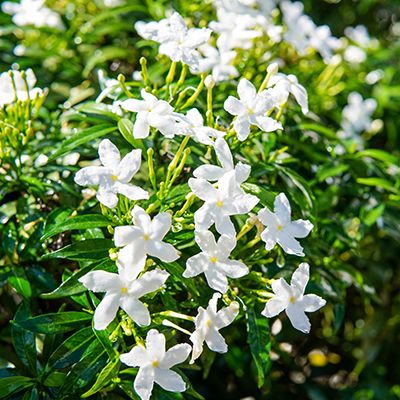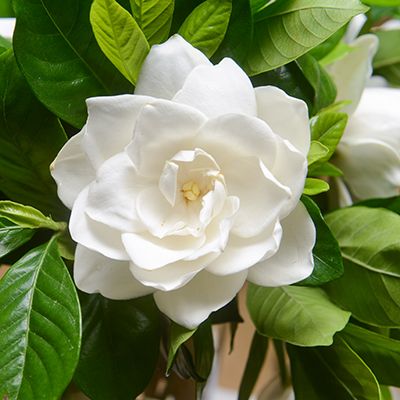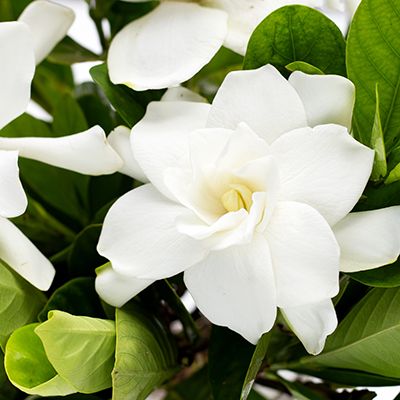


Gardenias
General Information: Gardenias (Gardenia augusta or Gardenia jasminoides) are evergreen plants native to China, Taiwan and Japan. They have been in cultivation since the eighth or ninth century. There are at least 15 varieties of this Gardenia plus two more species. Probably the best known among long time gardeners is the ‘Mystery Gardenia’ which was a favorite for corsages during the mid-twentieth century.
Gardenias can be grown anywhere in the Bay Area. They are not fragile, delicate plants requiring the professional touch of a Master Gardener. Some people have had more consistent success growing Gardenias in containers rather than in the ground. If you choose a container, use pure Master Nursery® Gardener’s Gold™ Potting Soil as the planting media. (Under no circumstances should you use house brands of any of the big box stores.) The container must be at least a 15 gallon size. If you plant in the ground, dig the hole two or three times as wide as the plant’s container and one inch less deep than the soil in the container. Mix two-third native soils with one-third Master Nursery® Gold Rush or Master Nursery® Bumper Crop and use this as the back-fill around the root ball of the Gardenia.
Gardenias flower best when they get almost a full day’s sun. They flower poorly in filtered or half day sun. Morning sun is not enough. Planted in the ground on the west facing side of the house is a good location and should give you many blooms. When possible, locate the plant near an entrance so you and your guests can enjoy the fragrance as you enter or leave the house.
Of the 15 varieties of Gardenias, ‘Mystery’ produces the largest blooms, becomes tallest but can get “leggy”. ‘August Beauty’ blooms best in August while ‘Radicans’ is very small and suitable only for edging. ‘Veitchii’ holds at about three feet by three feet or a bit larger; is green to the ground and blooms for 8 to 10 months of the year. The flowers on ‘Veitchii’ are not as large as ‘Mystery’ but there is more of them and they are equally fragrant.
Gardenias in containers must be fertilized monthly with Master Nursery® Camellia, Azalea, Gardenia and Rhododendron Food. Those in the ground should be fertilized every three months. Normally, this fertilizer has enough iron and sulfur to maintain a dark green color in the plant. Bay Area water is very alkaline and plants growing near a house foundation receive more lime which may cause foliage to become yellowish. If this happens, supplement the fertilizer with iron sulfate or sulfur soil corrective twice a year (Valentine’s Day and 4th of July).
The amount of irrigation Gardenias require depends on soil composition, size of plant and temperature.
For Containers: Start by watering once a week until water runs out of the bottom. As the plant increases in size and if the temperature increases, watering twice a week may become necessary. Plants in the ground should be on the same schedule with enough water applied to go to the bottom of the root ball. The top two to three inches of soil should be dry before the plant is watered again.
Fungus Diseases seldom affect Gardenia plants. Aphids may be a minor problem but can be controlled with horticultural soap spray. Flower buds may turn brown and drop off before opening. This is a symptom of damage by thrips insects. One solution is to spray the whole plant, once a month with Bonide® Captain Jack’s DeadBug Brew. Another suggestion in the prevention of this problem is by sprinkling Bayer Advanced™ Fruit, Citrus & Vegetable Insect Control, twice a year, on containerized Gardenia soil. If your gardenias are planted in the ground they may only need to be treated once a year. These insecticides will also control aphids. Because these blossoms are not visited by bees, these insecticides will not be a problem.
Gardenias can be cut any time and even one of the smaller Veitchii blossoms will provide fragrance for an entire room. Cut the flower when it is about three-quarters open and remove all but the top-most leaf before placing it in a vase filled with water. Cut about one-quarter inch off the stem, again, immediately before placing it in its vase.
During certain seasons of the year (usually late spring), large numbers of leaves will turn totally yellow and then fall off. This is normal and botanists will refer to it as senescence. Gardenias are evergreen so that the whole plant retains greenery year round. However, each individual leaf has a life span of about two years. The oldest leaves are those closest to the interior or to a main branch or at the bottom of the plant. When these leaves are two years old, they gradually turn yellow and fall off. A large number may fall off within a short period of time and cause the homeowner to fear for the health of the plant. As the leaves turn yellow, all of its cell nutrients leave and move into the new leaves. When the yellow leaves drop, examine the young leaves at the tips of branches. As long as the new leaves are a healthy green, the plant is normal.